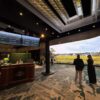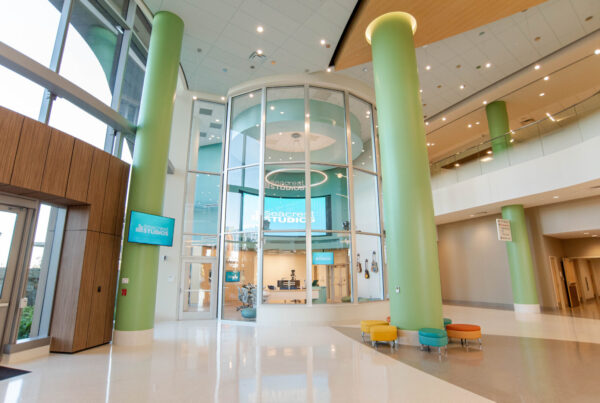Today’s universities are under increasing pressure to keep up with the latest technology trends. This is particularly true when it comes to AV solutions, which are crucial for everything from instruction and learning to attracting top talent. Earlier this month, Bluewater hosted a virtual roundtable with Crestron and Calvin University to discuss some of the top trends driving AV on campus. Check out the summary below or view the full recording at bluewatertech.com/ondemand
Featured Speakers
- Jeff Imhoff, Senior Account Executive at Bluewater Technologies
- John Hulen, Director of Channel Marketing at Crestron Electronics
- Adam Tozer, Classroom and Production Technology at Calvin University

Hybrid and Remote Learning Trends
The first topic of discussion was hybrid and remote learning trends. John kicked off the topic by discussing the urgency that followed the pandemic for universities to quickly implement remote learning across the board. He explained how many universities are now taking a step back and analyzing the need to keep some of this remote technology in place and also reassessing whether or not it needs to be in every classroom. In response to being asked what Calvin University’s plan is as far as what percentage of classrooms are going to be equipped to support hybrid or remote learning, Adam explained:
“We’re a smaller campus with only around 150 classrooms. Traditionally, we’ve been an in-person only learning environment and now we’re slowly shifting to an online program and also moving to a hybrid model. We’re currently thinking that we would like at least 10-15% of our classrooms to have some remote technology…”
Adam added that one of the greatest challenges is figuring out how to integrate remote learning technology into specific spaces that may not have initially been designed to work efficiently with a hybrid or remote learning model. Calvin University’s plan is to roll out this new technology in phases to ensure everything is working as expected before making a huge investment.
User Experience
John brought up another pressing issue within hybrid and remote learning trends – user experience. He explained that especially with blended or hybrid learning spaces, there’s usually multiple users and it’s important to take that into consideration. Whether it’s the faculty using the technology or the students, the technology needs to work efficiently and be easy to use for everyone. Adam agreed that the user experience issue is a challenge:
“We found out during the pandemic when we had to quickly implement temporary technology into some of our spaces, it was difficult to make it work well reliably and that leads to a lot of frustration and a lot of classes who didn’t get to do what they wanted to do during their class session just because the technology didn’t work.”
With more and more universities following this trend of hybrid and remote learning, all of our speakers agreed that whatever technology universities decide to implement, it needs to work seamlessly to be effective. Adam added that they are considering adding Flex for Microsoft Teams into some of their hybrid learning spaces to help simplify the process for faculty.
Audio & Video
John brought up another important point regarding hybrid learning technology – video. When it comes to camera shots, there are lots of different options including auto tracking or speaker tracking, group framing, presenter tracking and more. Adam explained that tracking cameras are a popular choice but some find that they don’t always work correctly. Calvin University is currently using PTZ cameras in their hybrid learning spaces with simple presets to stream either the front of room or entire room, for example. This helps to simplify the technology for the faculty.
Jeff added that as an AV integrator, Bluewater has experience with working in a wide variety of classrooms. He explained that the decision concerning what kind of AV equipment to use usually comes down to cost and wanting a simplified user experience over a complicated system with more options. Jeff also raised another point – how do we mic the space? Should the classroom audio be set up to be presenter only or is it hybrid? Adam responded by stating that at Calvin University, they’ve opted to implement a ceiling mounted mic array that has the ability to capture the entire room if needed but still be focused on the instructor’s space.
Active Learning Spaces or “Flipped Classrooms”
The pandemic definitely shook up the way education is done. One lasting trend that’s here to stay? Flipped classrooms! By turning conventional learning on its head, this method empowers students with student-led active learning, collaboration opportunities and personalized guidance. Essentially instructors are able to create digital content for their classes that can be accessed outside of class time leaving more time for discussion during face-to-face lessons.
Jeff explains that he is seeing lots of universities implement active learning spaces complete with multiple displays and stations where students can work in groups or individually. These types of classrooms are used in various ways and can be a very efficient way to promote active learning. John added that there is some complexity that goes along with this type of space and asked Adam – How is Calvin University is making some of these complex spaces a little more simple to use? Adam responded:
“In these complex spaces the biggest key factors are flexibility and simplicity. One approach is to install all of the technology on the outside walls. This enables the instructor to move tables and chairs however they see fit and also creates a more open space. To promote a more user friendly experience, we’ve implemented automatic presets to control the entire room.”
All our speakers were in agreement – active learning spaces are a revolutionary trend that will be around for the long-haul!
How Technology Increases Student Engagement
When it comes to engaging students, universities are constantly looking for new ways technology can facilitate learning and increase student involvement. From online collaboration tools to AI-enabled classrooms, modern technologies have the potential to increase student engagement. John asked Adam if he’s noticed an increase in student engagement at Calvin University as a response to the technology they’ve installed. Adam explained how the flipped classroom model has really helped with student engagement as it allows the students to have more time in class to ask questions and engage with others since they are digesting most of the course information beforehand. He also added that the newer students coming into college now have higher expectations in regard to technology. They want to be able to access course materials and lectures online regardless of whether they are taking a course remotely or in person.
Adam also explained that different types of learning models such as in-person, virtual or hyflex may affect student engagement depending on the subject being taught. He explained the importance of taking the time to figure out what the best model of learning is for each specific class. John was in agreement and brought up a quote from an article he has been working on:
“The current generation of digital native learners who have never known a time without the internet find critical human connection through technology.”
John explained it’s important for instructors who may be set in their old ways of teaching to keep this in mind when thinking about how technology affects student engagement, especially with the younger generation. Jeff brought up another great point, he explained that allowing students to access course materials and lectures online gives them the opportunity to not miss out on anything if they are unable to attend on a certain day. Back when all courses were taught in person only, if a student was out sick one day they would completely miss what was taught or have to rely on someone else for notes.
Supply Chain
The record number of schools and universities wanting to update their classroom technology following the pandemic has caused issues with supply chain. Jeff explains that this has been an issue from day one of the pandemic. With so much demand for technology, manufacturers are finding it hard to keep up. John asks Adam how Calvin University deals with delays and supply chain issues. Adam explains that this has been a challenge, they initially decided to go all in on virtual control but then pivoted to ordering used equipment through online sources such as Amazon, eBay and Facebook Marketplace. They utilized the used equipment temporarily until their new equipment came in and now they have a stock of backup equipment to use in the future if needed.
Adam brought up another issue regarding supply chain – If we order something now, but it’s not going to come in for 8 months, is that on next year’s budget or this year’s budget? He explains that Calvin University has moved to a model of capital expenses which transfers between budget years so if it does happen to cross over the budget year (due to delays) that is okay as long as it’s communicated appropriately.
Jeff brought up another great question – How do you plan for the future when you know the tech is over a year out? John agreed it’s very difficult to plan and explains that they are starting to see a decrease on lead times for Crestron Equipment and that they even have products available right now. These are all signs that things are trending in the right direction and he is hopeful the supply chain issues will start to subside. As they were wrapping up, the panel received a question from the audience:
“Will the tech I order today be relevant when it arrives in a year?”
John explained that there shouldn’t be any issues with the tech becoming irrelevant within just a year or even two. He stated that most of the universities Crestron is working with are planning for 6-8 year refresh rates. They are also rolling out firmware updates on a regular basis that will help keep the equipment up to date and add additional features as they become available.
View the full recording of this virtual roundtable at bluewatertech.com/ondemand











